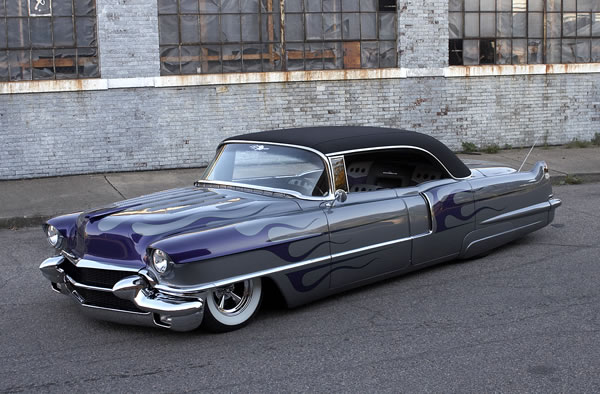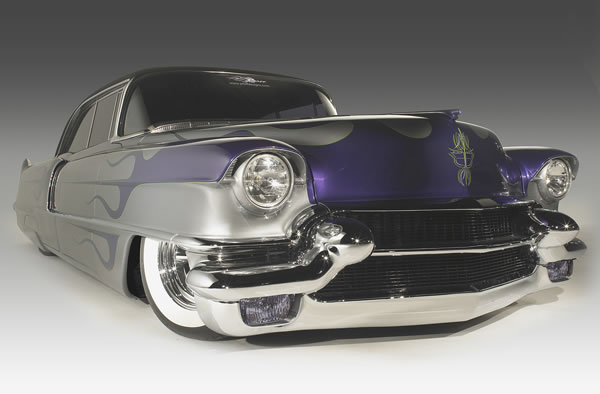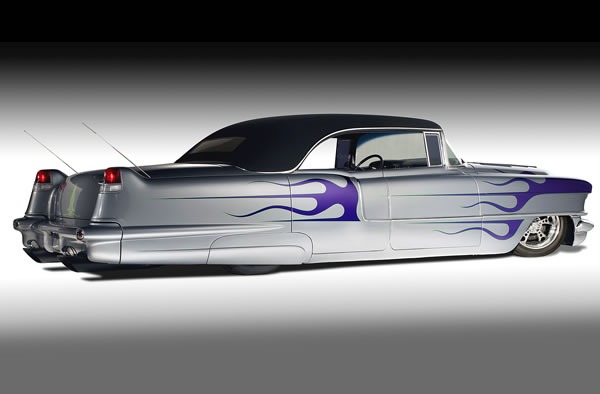
Stars twinkle. Violins play. It’s love at first sight, the beginning of a relationship that will span 23 years, four makeovers, and thrill millions with freaking awesome, 20-foot-long flames. You see, this Caddy—aptly named FireMaker—is the automotive manifestation of owner Murray Pfaff’s affinity for shooting flames out the back ends of cars.
Murray is well known as an automotive designer and car builder. His studio, Pfaff Designs, has designed over 250 concept cars, bikes, and other wheeled vehicles for the likes of the late Boyd Coddington, Rad Rides by Troy, Air Ride Technologies, Pro Rides, Detroit Speed & Engineering, and Roush Racing. Two of his designs—the G-Force GTO and Sidewinder Cobra—became Hot Rod magazine project cars. Murray is also celebrated in the Detroit area for throwing nutzo Woodward Dream Cruise parties that end with an automotive immolation or implosion of epic proportions.
But we digress. When young Murray first found the Cadillac back in ‘86, it had been sitting unloved since 1971. With its barn home slated for demolition to make way for a shopping mall (savor the irony of that in today’s environment), Murray asked his father for permission to buy the car. Mr. Pfaff’s “over my dead body” response put the kabosh on the purchase.
However, fate intervened and found a safe haven for the Cadillac. Five years after dad put his foot down, Murray was able to buy the car. With help from his friend Matt Shamey, Murray dove headlong into Makeover Number One. It was a biggie, too—modifications included a Carson-style top, over 300 hood louvers, shaved handles, trim, and emblems, custom fender skirts, frenched antennas, and filled bumpers. Murray covered the car with a mint green, monochromatic paint job; his brother Dave and a collection of friends rebuilt the Caddy’s mechanicals and got the car on the road.
And just in time, too, as Murray and the de Ville made a move to Naples, FL shortly afterward. After five years in the Florida sun, Murray decided it was time for Makeover Number Two. This one took the form of a 500-cubic-inch V8, Turbo 400, and rear axle from a 1976 de Ville. This was no plug-and-play deal. While the engine compartment of a 1956 Cadillac is large, it ain’t 500-cubic-inch-motor large. To create the required space, a six-cubic-foot wheelbarrow gave its life to become a firewall recess. The front crossmember was C-notched for oil filter clearance, and the center X-member was modified to make room for the Turbo 400. Murray also laid on a new deep jewel green top color with flame graphics.
Another move, this time to Northern California, prompted Makeover Number Three for the Cadillac. The mint green color was traded in for a deep silver poly over jewel green with purple flames. The flame job was one of Murray’s first ventures into computer design, setting the stage for his design business.
A job transfer meant a move from the Golden State to Royal Oak, MI in 1999. After tiring of the stuffy corporate climate, Murray formally opened Pfaff Design in 2005. Makeover Number Four came a couple years later. Upgrades included Air Ride Technologies Shock Waves out back, new chrome and glass, a killer interior by PJ’s Trim Shop, and a Pfaff-penned Dark Silver paint job with Ultra-Violet Purple and Ice Pearl flames and scallops. Murray swaps out the rolling stock—“traditional” BF Goodrich wide white tires on 15-inch U.S. Wheel Supremes or “modern” Goodyear F1s on Pfaff-designed 18-inch Billet Specialties wheels—to suit his mood.
So what’s the deal with the flames? It all started when Murray was living in Florida. He began experimenting with the traditional type popper-type systems (basically spark plugs in the exhaust tips, juiced with voltage from the car battery). When that got old, Murray developed more sophisticated systems that injected a shot of fuel into the exhaust gas stream to create long gnarly balls of fire. The current setup is a two-stage system with fuel injection and two plugs per exhaust tip. It’s good for those 20 foot-long flames we talked about earlier—and we have the pix to prove it.
With so much history between them, it’s a sure bet that Murray will never part with FireMaker. However, his restless creative soul is working on a stable mate for the Cadillac. We’re sworn to secrecy on the project, but we can tell you it’s a Mopar, was found in a barn, will have a 6.1L Hemi, and—well, that’s about it. Trust us—this new ride will be an eye-popper in the finest Pfaff Designs tradition.
No flame-throwing shenanigans with this one, though.
FAST SPECS
Chassis
Frame: Stock 1956 Cadillac with modified X-member to clear TH-400 transmission,
C-notch in front crossmember to clear oil filter
Rear Axle: 1976 Cadillac 12-bolt with 2.73:1 ring and pinion
Front Suspension: Rebuilt 1956 Cadillac
Rear Suspension: RideTech Shockwaves with digital remote control
Brakes: one-inch GM front disc, stock rear drum
Wheels and Tires, Modern: One-off 18-inch Billet Specialties wheels designed by Pfaff Designs, 235/50-18 Goodyear Eagle F1 tires
Wheels and Tires, Traditional: 15-inch U.S. Wheel Supreme wheels, 225/70-15 Coker Tire BFGoodrich Silvertown radial tires
Engine and Transmission
Engine Type: 500 C.I.D. Cadillac V8, 500 horsepower/650 ft.-lbs. torque
Short Block: Rebuilt factory
Cylinder Heads: Rebuilt factory
Induction: Edelbrock Performer intake manifold, 850 cfm Holley Street Avenger carburetor
Ignition: Stock HEI distributor, MSD 6A ignition box
Exhaust: Sanderson headers, Flowmaster mufflers, handmade flamethrower exhaust tips with integrated twin spark plugs
Cooling: Be Cool aluminum radiator, twin 11-inch electric fans and controller
Dress Up: Koken aluminum air cleaner (shampoo drain off of barbershop chair), Offenhauser 365 Cadillac valve covers machined to fit
Other Items: Tuff Stuff chrome accessories, Earl’s braided black lines and black anodized fittings, 1969 Corvette master cylinder, 1982 Olds Cutlass power brake booster, 250-amp alternator by Ohio Generator
Transmission: TH-400 built by Detroit Gearbox, 2,500 rpm stall torque converter
Body
Modifications: Shaved handles, emblems, trim, and antenna, filled side skirts with custom body line, extended side intakes with modified trim, recessed firewall made from wheelbarrow
More Modifications: 300 louvers in hood, Cadillac Goddess relocated and recessed into hood line, Carson style top with black Mercedes Haartz cloth
Even More Modifications: Motorcycle headlights with chrome bullets, One piece rear bumper with 1948 Ford taillights molded into bumper ends, custom taillight bullets
Son of Modifications: Custom stainless windshield trim, twin-frenched electric rear antennas, Hella driving lights recessed in front bumper
Bodywork: Owner and Matt Shamey, Watertown, NY
Paint
Paint: Glasurit Dark Silver basecoat/clearcoat
Graphics: Glasurit Ultra-Violet Purple/Ice Pearl flames and scallops, Galaxy Green pinstriping
Paint: Charlie Vickerie, Waterford, MI
Graphics Design/Layout: Owner
Pinstriping: Jeff Shea, Warren, MI
Interior
Upholstery: Black leather with purple suede/gray leather/embossed leather seat inserts
Front Seats: Nissan bucket seats with vintage Cadillac Eldorado emblems in seat backs
Carpet: Black loop carpet with suede floor mats
Dash: 1956 Cadillac with 1960 Cadillac speedometer cluster, fabricated dash inserts with hidden door for audio head unit
Console: 2006 Impala center console, modified to fit hand fabricated gauge cluster housing with Classic Instruments gauges
Steering: Ididit tilt steering column with modified 1960 Cadillac steering wheel
Shifter: B&M Quicksilver shifter with polished aluminum “devil skull” shift knob
HVAC: Vintage Air rear mount AC/heating system
Wiring: 18-circuit Painless Performance wiring harness, SPAL power doors/windows with eight-channel remote
Other Items: Clayton Machine door handles, modified 2006 Buick Rendezvous arm rests, fabricated stainless door sills with embossed leather inserts, overhead console with lighting and storage
Upholstery: PJ’s Trim Shop, Hemlock, MI
Other Interior Work: Owner with additional wiring by Tom Gardner
Audio
Head Unit: Alpine iDA-X001 Digital Media Receiver
Amplifiers: Four MTX Thunder amps, 3,000 watts total/19,000 watts peak
Subwoofers: Two MTX 12-inch Thunder 9500s
Speakers: MTX Thunder Axe component speakers
Wiring: Street Wires
Battery: Optima Yellow Top
Audio Installation: Street Legal Customs
Special Thanks To:
David Pfaff, Tom Gardner, Steve Langdon, John Marsh, Ed Pashukewich, Cliff McKillop, Bryan Spears
Photos by Jason Marker, Full Custom Photo









Good nice looking car , Antique and Rare collection of car.